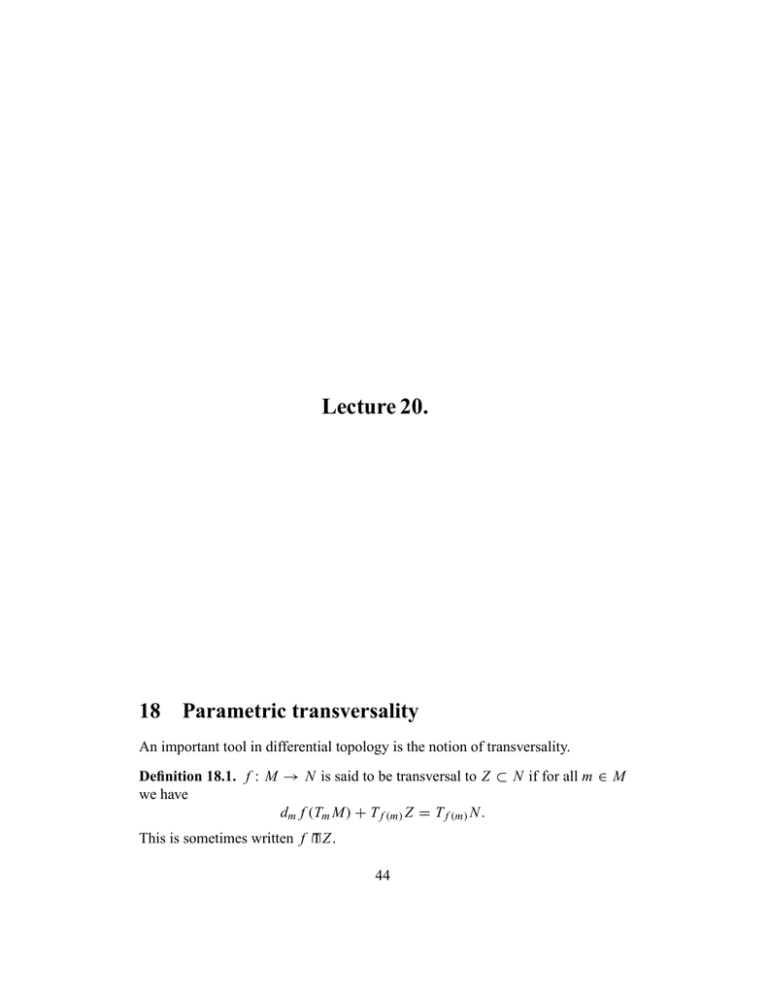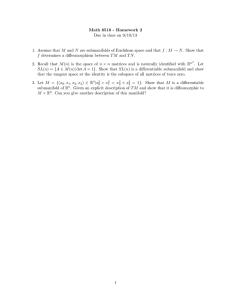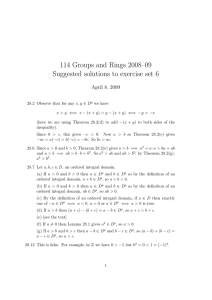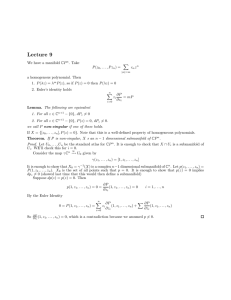Lecture 18 An important tool in differential topology is the notion of... we have
advertisement

Lecture 20.
18
Parametric transversality
An important tool in differential topology is the notion of transversality.
Definition 18.1. f : M → N is said to be transversal to Z ⊂ N if for all m ∈ M
we have
dm f (Tm M) + T f (m) Z = T f (m) N .
This is sometimes written f ∩
TZ .
44
Lemma 18.2. If f : M → N is transverse to Z then the preimage f −1 (Z ) is a
smooth submanifold of dimension
dim(M) − dim(N ) + dim(Z ).
Proof. Let x ∈ f −1 (Z ) and choose charts (U, φ) about x and (V , φ) about
f (x ) ∈ Z . We can choose (V , φ) so that ψ( f (x )) = 0 and ψ(V ∩ Z ) ⊂
Rz × {0} ⊂ Rn . Let p : Rn → Rn−z be the projection. Define g : U → Rn−z by
g(x ) = p ◦ ψ ◦ f |U (x ). Then the condition that f is travsversal to Z implies that
the origin a regular value of g and hence g −1 (0) = Z ∩ U is a submanifold.
Remark 4. Often one can make cleaner statements by introducing the notion of
codimension. If Z ⊂ N is a submanifold we define codim(Z ) = dim(N ) −
dim(Z ). It is the number of equations required to cut out Z locally. In the above
theorem the codimension of Z and f −1 (Z ) are the same. (They are each cut out
by the same number of equations!)
Our aim is to show that the condition of being transversal is generic in the
sense of Sard’s theorem. As a model for what we wish to prove consider the
following situation.
Let
F: P × M → N
be a smooth map.
Theorem 18.3. Suppose that F is a submersion, i.e. the differential of F is surjec­
tive everywhere. Suppose further that P, M and N are finite dimensional. Then
for each p ∈ P we get a map f p : M → N . Given a submanifold Z of N t for a
generic p ∈ P we have f p is transversal to Z .
Proof. Since F is a submersion F is transversal to Z so that S = F −1 (Z ) ⊂
P × M is a submanifold. Consider the projection
p1 : S → P.
Fix ( p, m) ∈ S and set n = F ( p, m) The tangent space of S at ( p, m) is (v, w) ∈
T( p,m) M so that d( p,m) F (v, w) ∈ Tn Z or equivalently
dm f p (w) + d( p,m) F (v, 0) ∈ Tn Z .
We claim that p is a regular value of the projection if and only if f p is transverse
to Z . This follows from
45
Lemma 18.4. S = F −1 (Z ) is transverse to { p}× M if and only if f p is transverse
to Z .
Proof. The first condition is
0 ⊕ Tm M + (d p,m F )−1 (Tn Z ) = T p P ⊕ Tm M
The second condition is
d p,m F (0 ⊕ Tm M ) + Tn Z = Tn N .
Since F is surjective these condition are equivalent.
Next we observe that the condition S is transverse to { p} × M is equivalent
to the condition that p is regular value of the projection p1 | S : S → P. The first
condition is
0 ⊕ Tm M + (d p,m F )−1 (Tn Z ) = T p P ⊕ Tm M
while the second is
d p,m p1 : (d p,m F )−1 (Tn Z ) = T p P.
Since 0⊕ Tm M is the kernel of d p,m p1 is 0⊕ Tm M these conditions are equivalent.
Thus we can appeal to Sard’s theorem applied to the projection p1 : S → P to
say that a generic p ∈ P is a regular value and by the lemma for generic p ∈ P,
f p is transverse to Z .
Theorem 18.5. Suppose that F is a submersion, i.e. the differential of F is sur­
jective everywhere. Suppose further that P , M and N are Banach manifolds for
each p ∈ P we get the map f p : M → N is Fredholm. Given a finite dimensional
submanifold Z of N then for a residual set of p ∈ P we have f p is transversal to
Z.
Proof. We simply need to check the map p1 | S : S → P is Fredholm. To this end
we need to inspect the proofs of the two lemmas above. We can sharpen them to
the following.
Lemma 18.6. There an isomorphism
T p P ⊕ Tm M/(0 ⊕ Tm M + (d p,m F )−1 (Tn Z ) → Tn N /d p,m F (0 ⊕ Tm M) + Tn Z
46
Proof. Differential of F induces a map which is easily seen to be an isomorphism
using the fact that F is a submersion.
d p,m p1 : (d p,m F )−1 (Tn Z ) = T p P.
Lemma 18.7. There an isomorphism
T p P ⊕ Tm M/(0 ⊕ Tm M + (d p,m F )−1 (Tn Z ) → T p P/d p,m p1 : (d p,m F )−1 (Tn Z )
Proof. Now the differential of p1 induces the desired map which is easily seen to
be an isomorphism using the fact that p1 is a submersion.
These two lemmas tell us that the cokernel of p1 | S is finite dimensional.
The kernel of the projection p1 |S is the intersection (0⊕Tm M ∩(d p,m F )−1 (Tn Z ).
This intersection Fits into a short exact sequence
0 → ker(dm f p ) → (0 ⊕ Tm M ∩ (d p,m F )−1 (Tn Z ) → Tn Z → 0.
and hence is finite dimensional.
The main application we will have of this result is the following result.
Theorem 18.8. Let M , N , and Z be smooth manifolds with Z ⊂ N a submanifold.
The set of maps f : M → N in C k (M, N ) which are transverse to Z is residual
in C k (M, N ).
A little later in the course we will deal with giving C k (M, N ) the structure of
a Banach manifold.
47







